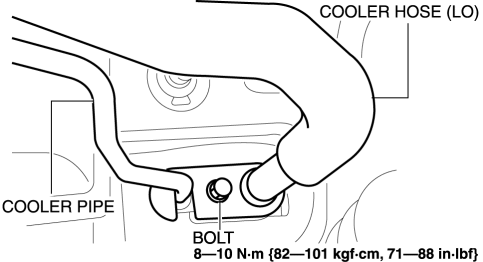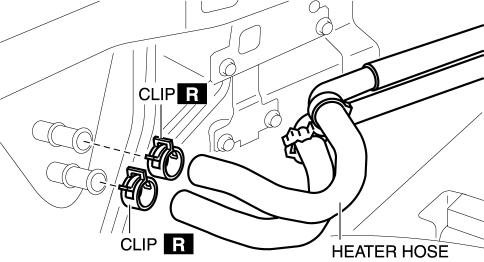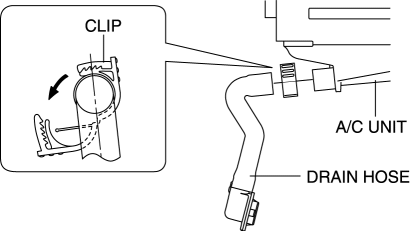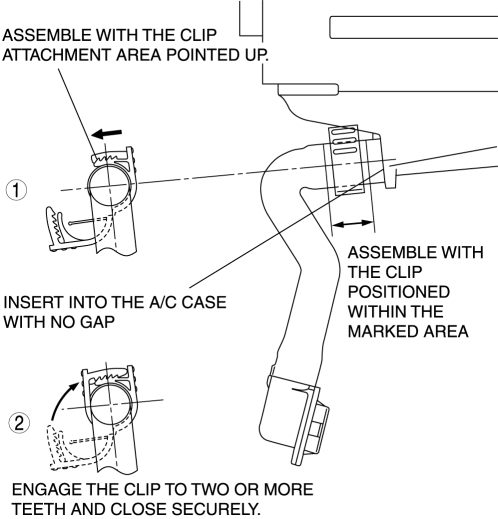Mazda CX-5 Service & Repair Manual: A/C Unit Removal/Installation
1. Disconnect the negative battery cable..
2. Discharge the refrigerant..
3. Drain the engine coolant..
CAUTION:
-
If moisture or foreign material enters the refrigeration cycle, cooling ability will be lowered and abnormal noise or other malfunction could occur. Always plug open fittings immediately after removing any refrigeration cycle parts.
4. Remove the bolt, then disconnect the cooler hose (LO) and cooler pipe.

5. Disconnect the heater hose.

6. Remove the following parts:
a. Windshield wiper arm and blade.
b. Cowl grille.
c. Windshield wiper motor.
d. Front scuff plate.
e. Front side trim.
f. Glove compartment.
g. Dashboard under cover.
h. Decoration panel.
i. Center panel.
j. Audio unit (with audio unit).
k. Front console box.
l. Shift lever knob (MTX).
m. Shift panel.
n. Upper panel.
o. Rear console.
p. Side wall.
q. Front console.
r. Shift lever component (MTX).
s. Selector lever component (ATX).
t. Hood release lever from the lower panel.
u. Lower panel.
v. Knee bolster.
w. Climate control unit.
x. Column cover.
y. Driver-side air bag module.
z. Steering wheel.
aa. Steering shaft.
ab. Switch panel.
ac. Meter hood.
ad. Instrument cluster.
ae. A-pillar trim.
7. Remove the dashboard..
8. Remove the blower unit..
9. Disconnect the drain hose.

10. Remove the nut, then remove the A/C unit. Do not allow compressor oil to spill.

11. Install in the reverse order of removal..
12. Inspect for engine coolant leakage..
13. Perform the refrigerant system performance test..
A/C Unit Installation Note
1. When replacing the A/C unit or evaporator, add compressor oil to the refrigerant cycle.
-
Supplemental oil amount (approx. quantity)
-
40 ml {40 cc, 1.4 fl oz}
Drain Hose Installation Note
1. Install the clip as shown in the figure.

 A/C Unit Disassembly/Assembly
A/C Unit Disassembly/Assembly
1. Disassemble in the order indicated in the table.
CAUTION:
If a non-specified grease is used, it may result in abnormal noise or improper
operation of the links. Apply only the specifie ...
 Air Intake Actuator Inspection [Full Auto Air Conditioner]
Air Intake Actuator Inspection [Full Auto Air Conditioner]
1. Connect battery positive voltage to air intake actuator terminal B (or C),
connect terminal C (or B) to ground, and then verify that the air intake actuator
operates as shown in the table.
...
Other materials:
Front Stabilizer Removal/Installation
CAUTION:
Performing the following procedures without first removing the front ABS
wheel-speed sensor may possibly cause an open circuit in the wiring harness
if it is pulled by mistake. Before performing the following procedures, disconnect
the front ABS wheel-speed sensor wiring ...
Hydraulic Lash Adjuster, Rocker Arm
Purpose, Function
HLA
The HLA maintains the valve clearance at a constant 0 mm and maintenance-free
valve clearance is realized.
Rocker arm
With the adoption of the needle roller bearing built into the rocker arm,
the contact to the cam employs rolling contact to reduce sl ...
Discharge Headlight Service Warnings
Discharge Headlight Service Warnings
When replacing a discharge headlight bulb, performing the servicing with
the negative battery cable connected or in a wet work area could result in electrocution.
When replacing a discharge headlight bulb, perform the servicing under the following
...
